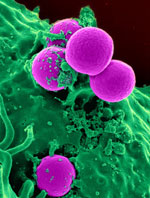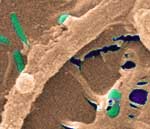Frequently Asked Questions about Mercer (aka MRSA)

Frequently asked questions about Mercer, MRSA and Staph.
~ Click each link to take you to the answer ~
What is Mercer Staph infection?
How do I get rid of MRSA or Staph?
Are MRSA and Staph contagious?
Do antibiotics cause mutations in bacteria and increase re-infection rates?
How do I stop having recurring infections?
Will I get better, what can I do about MRSA?
How do I care for someone with MRSA?
Can I stop taking antibiotics?
How long does Staph and MRSA live on surfaces?
Can MRSA cause heart or organ damage?
What is Mercer Staph Infection?

What is known as the “Mercer virus” is actually a bacteria called MRSA
Mercer infections are dangerous, contagious and hard to treat and are spreading from person to person in hospitals and public places. This infection is often pronounced “mercer” and it stands for MRSA (short for Methicillin-resistant Staphylococcus aureus). Many people call mercer bacteria a virus, but it is not a virus. Virus and bacteria are very different and are treated quite differently.
Mercer is also described with phrases like “Staph Superbug” and “MRSA Staph infection“. All of these phrases refer to the same infection and medical condition. Mercer, or MRSA is an infection with the bacteria Staph aureus that is resistant to many antibiotics and a Mercer infection can be a very serious or life-threatening infection. Click this link to find out more about MRSA and Staph infections.
What is the MRSA Disease?
MRSA disease is an infection caused by the bacteria MRSA, which is short for methicillin resistant Staphylococcus aureus. MRSA is caused by Staphylococcus aureus or "Staph," that has acquired an immunity or resistance to the penicillin type of antibiotics. MRSA can be acquired at a hospital or health care facility (HA-MRSA) or in the community in places like gyms, shopping centers, schools, etc (CA-MRSA). Find out more about what is MRSA and how to protect yourself.

See our PRIVACY POLICY
What is Staph and what is Staph Infection?
What is Staph? "Staph" is an abbreviation for the bacteria "Staphylococcus". Staph is a common skin bacteria that lives on most people and normally doesn’t cause any problems. It can cause mild infections in the body if you get a cut or scrape. There are actually many types of Staph. Staph aureus is a more specific strain of "Staph" bacteria that is normally present on about 30% of the population. This strain of Staph can be more toxic to the body if the right conditions are present. Staph aureus bacteria can also become very resistant to antibiotics, becoming MRSA – Methicillin Resistant Staphylococcus aureus.
What is Staph infection? As stated above, Staph is a normal skin bacteria that’s very common. Sometimes, if you get a cut or scrape, this bacteria can grow within the wound causing a Staph infection. Click the following link to learn more about what staph is.
Is there a cure for MRSA? Yes, MRSA is curable. However, we have all been programmed by the media, drug companies and even our doctors to expect a quick-fix “cure” for our health problems. The trouble is, each infection can involve a unique strain of bacteria and each person’s infection can be quite different from someone else’s infection. And, antibiotics are the only option we normally hear about, and they don’t always work for these infections.
Curing an infection is one thing. Keeping it from coming back is quite another.There is a cure for MRSA and Staph and there can be long-term freedom from these debilitating infections. Many people have been very successful at stopping their MRSA or Staph infection using methods you will see in the treatments section of this website. Find out more about MRSA cure facts & myths.
First, it’s important to know what you’re dealing with and what all your options are. If you’ve run out of options with mainstream medicine, then realize that you have many more options and much more hope than you realize. And even if antibiotics (or natural antibiotics) do stop your current infection, Staph and MRSA have a knack for coming back again.
The key to getting rid of these infections for good is to strike the infection from multiple fronts. This is something that quick-fix cures and too-good-to-be-true remedies just can’t do. It takes three essential steps to end these infections successfully and permanently. Here is a summary of how to get rid of MRSA in 3 steps.

Yes. Both Staph and MRSA can be very contagious. MRSA is easily spread from person to person through direct touch, from touching contaminated objects or surfaces, and even through the air as airborne MRSA. People infected with MRSA or Staph can spread the bacteria to other people easily. And carriers can spread the disease, even if they themselves don’t have an infection. Many people carry these bacteria on their skin and don’t even know it – they have never been sick and have no idea that they carry it. MRSA is a growing part of our society and all of us are exposed to MRSA bacteria more often than we realize. Your chances of catching it can be increased if you are elderly, have a weakened immune system, have taken antibiotics recently, or visit a hospital, healthcare facility or other high-risk environment.
There are many things that you can do to minimize the spread of MRSA infection and to protect against getting infected. It’s important to use effective as well as healthy hygiene practices. Many of these things, like boosting your immune system and raising your body’s pH, work very well once you begin doing them. However, many of these things fall outside of most doctor’s realm of expertise or familiarity, so you never hear about them. Click the link to learn more about our MRSA infection control.
The ONLY way to positively know if you have MRSA or a Staph infection is to have a laboratory test to confirm what kind of infection you have. Given how dangerous MRSA can be, I would insist on an MRSA test if I thought I had a Staph infection. It’s very easy to mistake spider bites and other infections for MRSA and taking the test is the only way to know for sure. The test is usually a "microbial culture test" and can take up to a week to get results. There are also newer DNA type tests for MRSA that are becoming more available too.
If you do have Staph or MRSA, you can also request an antimicrobial susceptibility test. This test will show exactly which antibiotics will work with your particular infection. Many people waste valuable time while their infections get worse because they are given the wrong antibiotics or broad spectrum antibiotics which won’t work against MRSA. See more about testing here.

Staph bacteria can go into hiding inside your body in “biofilms” for long periods of time.
Research performed by Dr. Lida Mattman has scientifically proven that some bacteria, including Staph, have learned how to change form and go into hiding inside your body for long periods of time. What causes these mutations? One big reason is stress caused by the use of antibiotics. I and other professionals believe this is a big reason why re-infection after using antibiotics is so common.
These mutated or “L-Form” bacteria are very hard to detect using standard diagnostic tests. L-forms are also more resistant to antibiotics and can be virtually invisible to your body’s own immune system. Like sheep in wolves clothing, L-Form bacteria can lay in waiting for an opportune time to cause a re-infection.
Another common cause of recurring infections and device or prosthetic infections are "biofilm" structures. Biofilms protect Staph and MRSA bacteria from antibiotics, from some natural treatments and from your own immune system.
These mutated forms of Staph and MRSA make treatment difficult and cause re-infection. Most doctors are not aware of biofilm or L-form mutations. It is therefore important to consider using approaches that minimize or do not cause mutations in Staph or MRSA. Some combinations of antibiotics have shown useful against L-Forms and biofilms. And, many natural antibiotics have shown effectiveness too. If you’ve been struggling with recurring infections, be sure your approach is appropriate for these infection mutations. Click the link to learn more about biofilms and recurring infections.
Recurring infections are the single most common issue that people have with Staph and MRSA. Staph bacteria can lay dormant form some time, undetected, only to come back later and cause re-infections. There is a lot of credible evidence to suggest that using antibiotics can cause this dormancy.
There are many things you can do to minimize the chances of having recurring infections. Boosting the immune system is the single most important thing to do, followed by using natural antibiotics that bacteria can not defend against. Click the link to learn more about dealing with reinfections.
Yes, there is hope to get rid of MRSA and Staph for good, and many people have been successful. Using therapeutic essential oils and herbal products properly can have significant effects in the short term. For long-term success, boosting the immune system is the single most important thing to do.
Understand that antibiotics may be necessary and life-saving, and both mainstream and alternative medicine can be used successfully together. The trouble is, most people never hear about any of these other options from their doctors. Click here to learn more about why MRSA or Staph can be difficult to stop and what you need to know to get better.
First, you need to protect yourself from becoming infected. It’s very common for MRSA to spread from person to person living in the same household, or even to people who are only visiting. Hand washing and personal hygiene are crucial, as are keeping high-contact surfaces disinfected. And, it’s critical to know that MRSA can travel through the air. It’s also important to maintain your body’s defenses and to keep natural remedies on hand to aid as preventatives.
Secondly, get the facts straight about MRSA and understand what you are dealing with. If you are providing hands-on care to someone with Staph or MRSA, be sure you know proper techniques for changing dressings, bathing, cleaning, laundry precautions and helping with any medications. The more you know about treatment options, MRSA testing, signs and symptoms and prevention, the better. Reading through this website is a good first step. Knowing the MRSA facts and myths will also be supportive in your knowledge.
Most importantly, understand your role as a caregiver and its limitations. A good caregiver is supportive, encouraging, well informed and does their best to provide hope and good advice. However, you should always get permission to provide care and help. And realize that you may not see eye to eye on everything and most people like to make their own decisions if they can.
Babies and young children are often treated with antibiotics for MRSA or Staph infections. While this may be life-saving and necessary, there are down-sides to using antibiotics. Because of antibiotic-created mutations and biofilm bacteria, I believe it’s important to consider natural antibiotics as well.
Babies are much more sensitive than adults. Many of the methods used for handling MRSA must be adapted to work safely and effectively on babies and young children. This is definitely true when using essential oils and other natural antibiotics. However, for any specific recommendations on a particular method, you should talk with your doctor or an alternative health care provider.
I am a big proponent of using any and all methods that are available if they are needed or appropriate. Antibiotics are one of those methods. Antibiotics do have a time and a place in many cases and can literally make the difference between life and death. Please consider that both Western medicine and Alternative medicine are valid. They both have their pros and cons, they complement each other well, and they can be used together successfully. However, do not stop taking antibiotics unless you have your doctor’s approval. Stopping antibiotics early is one reason bacteria can become antibiotic resistant. MRSA is a serious infection and you should always be watched over by a physician.
From my experience, essential oils are one of the most powerful natural methods I have used for skin infections and other illnesses. Using the correct type of oils properly and safely can provide quick results. There are also powerful herbs that are effective. However, if I needed antibiotics, I would take them gladly, knowing that I can counteract the side effects of these drugs using essential oils, probiotics, and methods of immune support. Click the link to learn more about mainstream medical treatments.
Although Staph can live on surfaces or clothing for days to weeks (depends on the temperature and humidity level), it doesn’t mean that it will make you sick. Staph and MRSA have to get off the surface and onto your skin, where it may or may not survive due to the presence of competing organisms (the friendly bacteria that live on you).
Even if it survives on your skin, it may simply live there and not cause an infection. In order to cause an infection there has to be a break in your skin (this can be from shaving, a cut or scrape, tattooing, etc). There’s not a clear cut answer for all cases as there are so many variables that would affect the longevity of the bacteria, but it is shorter term from days to weeks. Find out more on our MRSA contagious page.
Once inside your body, MRSA can cause endocarditis, and heart valve problems. It can also infect other organs in your body as well. These infections can also form "base camps" inside your body the form of biofilms which help them evade treatment and help cause the recurring infection cycle.
Staph and MRSA infections often lead to secondary infections, such as yeast infections or other bacterial infections, causing a downward spiral that often leads to other illnesses and diseases. In fact, the CDC has said that infections set the stage for a host of chronic health issues including cancers.





